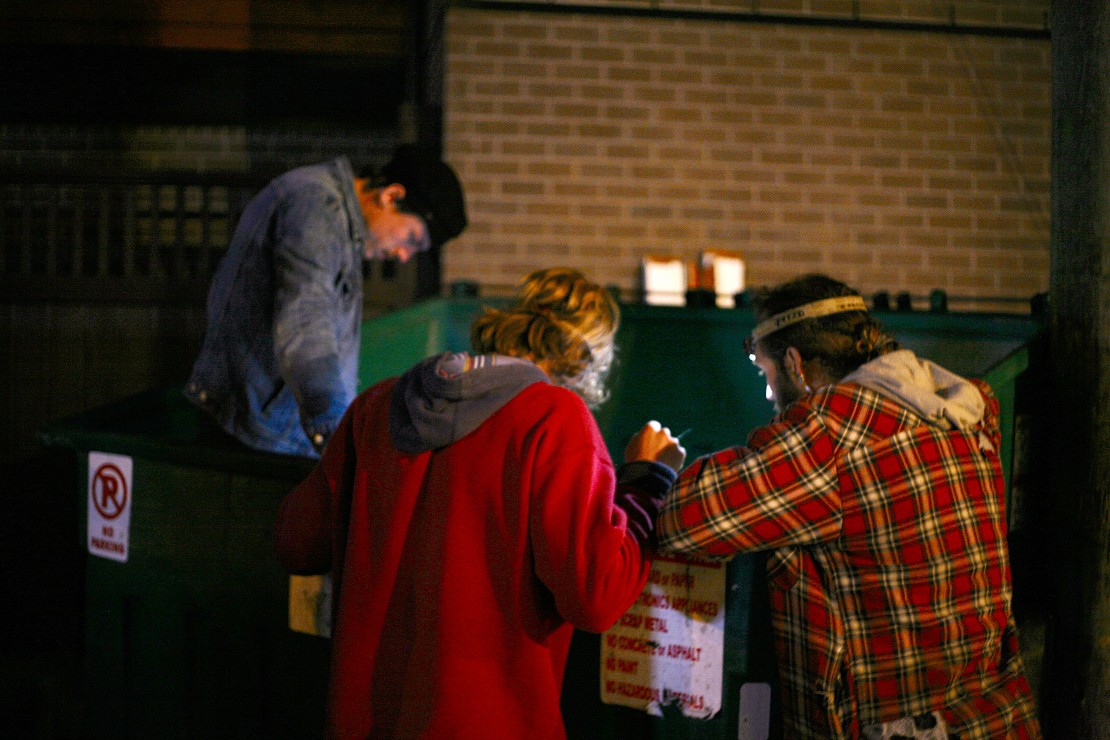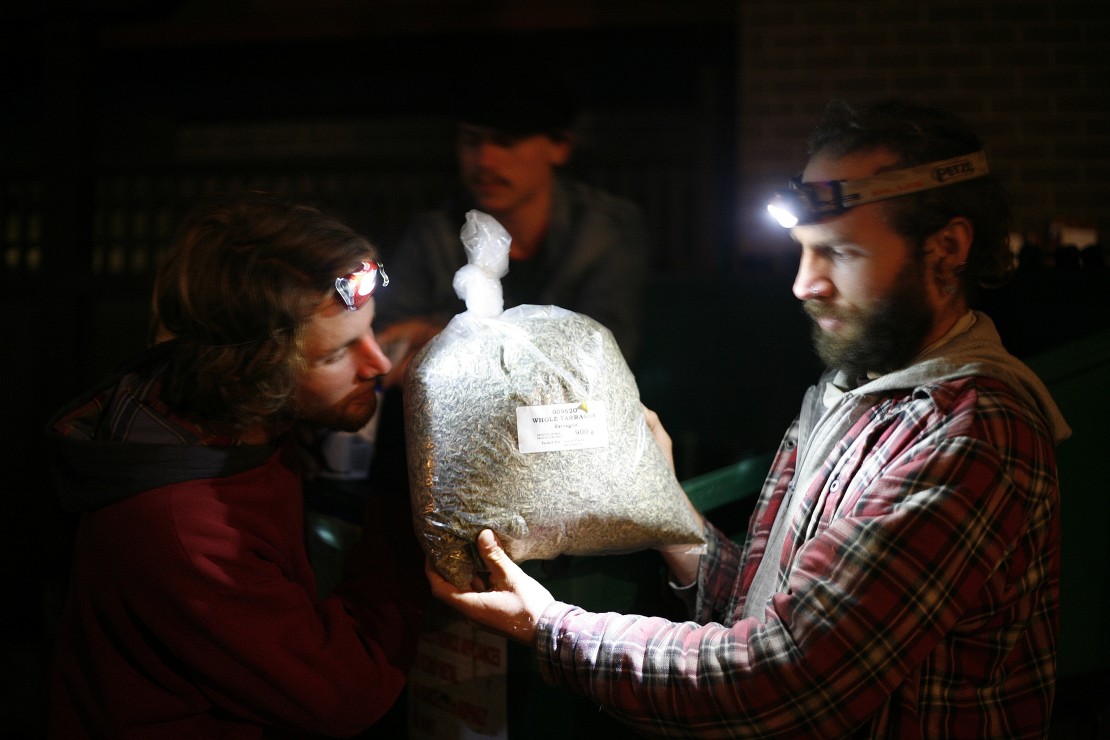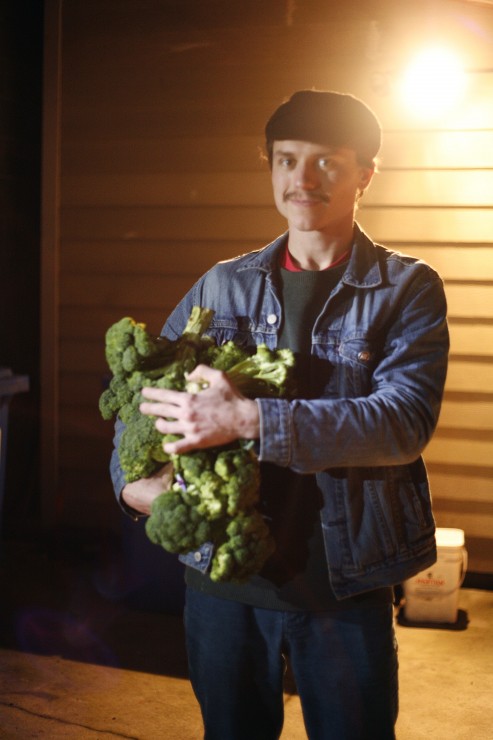The eight of us sat in a GMC VanDura Campwagon outside the Thrifty Foods on Quadra and Cook. It was dark—9:30 p.m. in early November. We were nervous and excited, unsure of what to do next. In the two front seats, Kaia Bryce and Michael Nyquist, the most experienced members of our group, mulled over the best course of action.
“Do you just want to hop out and . . . see if it’s worth it?” Bryce asked. “Alright,” Nyquist replied, and slipped out the door.
“This is sketchy, pulling up in this old van,” someone muttered. “All we need is ski masks and . . . ” The rest of the sentence was lost to our nervous laughter.
“This is pretty reminiscent of the old days,” said Bryce.
A moment later, Nyquist returned with a grin. “Awkward!,” he said, shaking his head. The first target of our food-reclaiming adventure was a dud.

Community Cabbage members inspect their find during a late-night run on Nov. 14. Photo by Belle White, Photo Editor
Dumpster diving makes people uneasy. For most, it’s associated with homelessness, half-eaten food, or bad hygiene. Merely mentioning the topic is commonly greeted with a grimace. But for a group of students at the University of Victoria, overcoming these societal misgivings has grown into a weekly ritual and a way to feed the campus at large.
The Community Cabbage is a three- year-old club with a unique focus on food literacy. Every Wednesday, they meet at a house in Gordon Head to collectively scour the city’s dumpsters for reclaimable food. The following day, they reconvene at the Emmanuel Baptist Church kitchen to inspect, wash, and cook the previous night’s haul. That prepared food is then served outside of UVic’s Student Union Building on Friday at noon. It’s an intensive process, but one that is thoroughly rewarding. On the first Wednesday that I participated, turnout was at a record high, with 23 people packing into a living room to chat, laugh, map out routes, and designate drivers.
The Cabbage doesn’t have a specified hierarchical structure, so the process on that particular Wednesday took a while. But the theme of sharing food was established immediately, with a plate of Eggo waffles passed around and freshly harvested sea urchin offered to anyone with the courage to have a try.
After a round of introductions, Bryce and Josie Simpson tag-teamed to explain the dive guidelines to the group.
“Leave it like you found it,” said Bryce. “Ultimately, it is someone else’s space . . . and in the event that someone does come out from the store and you have an interaction — that’s pretty rare—but if it does [happen, let it] be entirely on their terms . . . explain what you’re doing . . . but also if they ask you to leave, do that.”
Simpson continued: “We’re not the only ones that get food from dumpsters. A lot of people rely on them. So it’s good to be quiet and be surreptitious and be respectful so everyone can continue to do it.”
“We come from a place of relative privilege and other people who might not have our degree of comfort . . . rely on [food-scavenging] at a higher capacity than we do,” said Bryce. “So we need to do everything we can to make sure that [this food source] is accessible to those people, first and foremost.”
After a few more minutes of briefing, Simpson brought over a chalkboard and we were divvied up into cars. For five of the eight students in the VanDura, this would be our first dive. Bryce and Nyquist were old hands, and Fionnula Joyce had gone once before. But unfortunately, Nyquist’s initial attempt to check out the Thrifty Foods on Quadra and Cook hadn’t gone as well as we’d hoped.
“I walked up and started fiddling with the door on the compactor—it wasn’t locked,” Nyquist explained, “and [an employee] walked out with a big pile of cardboard . . . I said, ‘Are there any garbages around here?’ and he was like, ‘No, we just have the compost and the compactor, uh, I think that’s it.’”
We chuckled, Nyquist put the van into gear, and we were off to the next store: Lifestyle Markets.
The Community Cabbage model isn’t unique to Victoria. Similar groups can be found at many campuses across Canada. Midnight Kitchen at McGill, People’s Potato at Concordia, and Loaded Ladle at Dalhousie are all established food purveyors, and they laid the groundwork for Community Cabbage.
“Those are groups that inspired us,” said Bryce. “[We wanted] to take the model of having a kitchen where we can cook all this food and serve it and give back to the community and do some food education work . . . Our goal is to become as established as they are.”
Given the large turnout on Wednesday, things are looking optimistic for the club, but Bryce insisted there was much work left to be done.
“We need to have the support of UVic students. Because ultimately, we’re going to need some sort of funding in order to sustain our organization on a larger scale,” she said. “What that would probably look like is getting a share of the student fee and getting a student fee levy so that we’re able to hire and pay for a kitchen and hire a volunteer coordinator. So that’s a campaign that we’re starting to build up towards, and getting the support of students and the UVSS Board of Directors.”
At Lifestyle Markets, the dumpsters were old school—no compactors in sight. Nyquist squeezed the van down an alleyway and we filed out to inspect the goods.
The act of diving itself is nowhere near as grimy as it’s made to seem. Most garbage is thrown out still sealed in its packaging, and produce is often bagged. At the back of this grocery store, a box containing packets of vegan jerky sat atop a recycling bin—a meal just waiting to be had.
Two minutes later, we’d filled a pair of cardboard boxes to the brim. Litres of yogurt, all in sealed tubs, and—in some cases—yet to expire, filled one box. Vegan jerky, loaves of bread, and a bag of rice filled the other. We hauled them into the back of the van, along with two pristine pumpkins, and hit the road again. Next stop, Thrifty’s Fairfield.
For grocery stores, the argument against giving away certain food over throwing it out is nuanced. Nothing about dumpster diving is illegal, as long as there’s no trespassing involved — garbage is considered public domain. However, the laws around donated food are vague. In the Food Donor Encouragement Act of 1997, the provincial government states: “A person who donates food, or who distributes donated food, to another person is not liable for damages resulting from injuries or death caused by the consumption of the food unless . . . the food was adulterated, rotten or otherwise unfit for human consumption.”
While the introduction of that law cleared up some of the legal responsibility surrounding food donation, it also allowed plenty of room for interpretation. And given what I saw in Victoria’s dumpsters that Wednesday, “otherwise unfit for human consumption” unfortunately covers swathes of entirely edible food.
At the next Thrifty’s we explored, there was an opening beneath the trash compactor where we could get at recently disposed food.
“Oh, a raccoon!” Joyce said, and pointed at an animal scurrying in the shadows. On exchange from the University of Essex, this was her first up-close encounter with a fellow scavenging mammal.
“We need to [make] a bit of an assembly line,” Bryce said, corralling the group. Nyquist began reaching into the depths of the bin, and the rest of us compiled his findings and carried them to the back of the van. Minutes later, we had amassed a huge amount of produce. Pears, bananas, apples, tomatoes, asparagus, broccoli, and an entire watermelon—all in great shape or with minor blemishes—filled two boxes.
Back in the van, we decided to make one more trip to a bagel shop to snag the day’s unsold baking. On the way, Joyce remarked on our recent wildlife interaction: “They’re such cool animals . . . so exotic.”
One of my fellow first-timers mentioned that Planet Earth II would be featuring the raccoons of Toronto. “I would love to see that!” said Joyce, and we all laughed. But beneath the joking was an insightful point: like the supposedly shady world of dumpsters and dumpster divers, raccoons are often dismissed as cumbersome, disease-carrying pests. In reality, they’re some of the most intelligent creatures to be found in urban environments.
As we continued towards the promised land of bagels and baked goods, I asked Nyquist and Bryce about their most memorable finds.
“The one that comes up for me is two summers ago, we found three or four fillets of salmon,” Nyquist reminisced. “Prime cut salmon, it was incredible. It was sealed and that was just really wonderful. We . . . wrapped it in tinfoil with lemon and cooked it over a fire.”
“In terms of monetary value . . . I’ve stumbled across three or four hundred dollars worth of cheese,” said Bryce. “[And] a few weeks ago at the Root Cellar we found maybe twenty percent of a huge green dumpster . . . just chock full of frozen meat, and frozen really high-quality meat from the Root Cellar, locally-raised, hormone-free, organic. That was pretty crazy.”
“Also, on the same night we found an unreasonable amount of bacon, and this wasn’t the first time,” Nyquist added. “Two years ago we found thirty-two packs of bacon. Primo, thick- cut . . . it’s all sealed and cured. There’s nothing wrong with it. So we were giving out bacon to all our friends. I was eating bacon, like, every day of the week.”
At the bagel store, the pickings were slim, but we managed to fill a small bag with assorted flavours. Again, there was little wrong with the goods beyond their day-oldness.
One common misconception around grocery store food is with ‘best before’ dates. Most of the products we buy for consumption are stamped with a date in the near future, and we tend to steer clear of any food that ages beyond that point. But the numbers labeled on our milk jugs and meat packets aren’t necessarily indicators of food safety. In fact, the only thing that those dates are guaranteed to do, according to the Canadian Food Inspection Agency’s date labelling guidelines, is to “give you information about the freshness and potential shelf-life of the unopened foods you are buying.”
The only foods that actually expire, and must be clearly marked with an expiration date, rather than a best- before date, are baby formula and other human milk substitutes, nutritional supplements, meal replacements, pharmacist-sold foods, and formulated liquid diets. Everything else is simply at its “freshest” until the date indicated.
As the VanDura rumbled us back to home base, Bryce told me that she doesn’t necessarily think the goal of the Cabbage is to inspire a large number of dumpster divers, per se. “I think what we’re trying to do is to get a group of us who are curious to get more invested in this project, in this idea that food has so much more value than is reflected in the way that it’s being discarded,” she said. “So what we’re trying to contribute to is a broader sustainable and ethical food movement.”
At 11:30 p.m., our VanDura group was the last to make it back to the meeting house. We were greeted with loaves of bread from Woodfire bakery, even more yogurt, and packets of Caribbean jerk sauce. The haul was big enough for everyone to go home with something of their own. Along with the food, we all exchanged stories; Joyce enthusiastically told the group about our raccoon encounter.
But Lane Chevrier, one of the more experienced Cabbage members, seemed confused. And then it clicked. “Oh, you said you saw a raccoon. I thought you said ‘I was a raccoon.’” The group burst into laughter.
Joyce answered: “We all were.”












